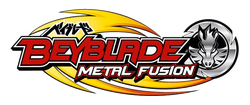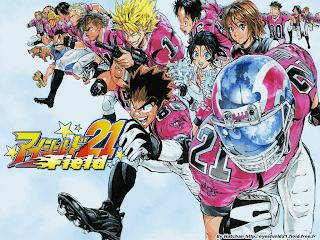Beyblade Metal Fight
01.00 |

Beyblade: Metal Fusion
| Story |
| Beyblade: Metal Fusion (Metal Fight Beyblade) | |
|---|---|
 | |
| Genre | Action, Adventure, Comedy, Manga |
| TV anime | |
| Director | Kunihisa Sugishima |
| Studio | Tatsunoko Synergy SP |
| Licensor | Nelvana |
| English network | TV Tokyo YTV Cartoon Network |
| Original run | April 5, 2009 May 15, 2010 –March 28, 2010 March 12, 2011 |
| Episodes | 51 |
| Succeeded by | Beyblade: Metal Masters |
Beyblade: Metal Fusion (Japanese: Metal Fight Beiburedo) is an anime spin-off of the original Beyblade anime series and is based on the Japanese manga, Metal Fight Beyblade. It is created by Tatsunoko Pro, Synergy SP, and is co-produced by Nelvana. Beyblade: Metal Fusion Saturdays at 7:30 on Cartoon Network in U.S. This Beyblade series features a complete new set of characters, and a new story. With a new series being developed in 2008 from the Beyblade series that once concluded with the original Beyblade series, a media mix developed with the anime as wellmas the manga. In contrast to previous work which uses the Four Beasts as motifs, Beyblade: Metal Fusion uses constellations as motifs. Also, in the previous work it was mainly team battles, but in this work it is mainly individual battles. Furthermore, Japan was the setting in the first series up until the end.
The first part was from Chapter 1 to Chapter 7 which became the original, and from Chapter 8 was the second part, becoming the Battle Bladers arc. In the anime, from Episode 24 became the Battle Bladers arc and was released on DVD as well from Vol. 01.
Although Battle Bladers was held as a tournament, the battle combinations in the anime and manga differ.

The Metal Fight Beyblade anime was broadcast by TV Tokyo from April 5, 2009 to March 28, 2010. From April 4, 2010 a new series, Beyblade: Metal Masters (Big Bang Bladers), It premiered on June 26, 2010 in U.S. and ended on March 12, 2011.
It is followed by Beyblade: Metal Masters.
Episodes
Main article: List of Beyblade: Metal Fusion episodes
Manga and Anime Details
The chapters of the Beyblade: Metal Fusion manga are written and illustrated by Takafumi Adachi. In Japan, they have been published in Shogakukan's Monthly CoroCoro comics since September 2008. The plot follows the adventures of Gingka Hagane, a beyblader who meets up with a boy named Kenta Yumiya, and the two become fast friends. They also meet a Beyblade Mechanic, Madoka Amano, who also joins them. Kyoya Tategami, andBenkei Hanawa from the Face Hunters become good guys and aid Gingka on his quest to defeat the evil Dark Nebula organization. An airing anime adaptation, produced by Tatsunoko Pro and Synergy SP, co-produced by Nelvana premiered on TV Tokyo on April 5, 2009. Beyblade:Metal Fusion's twenty chapters have been released in Japan so far. In the monthly CoroCoro comics, the chapters do not have specific chapter titles and are grouped by story arc name and chapter number instead. The chapter names are only in the Shinshoban manga volumes. The individual chapters are collected by Shogakukan in a series of Shinshōbon volumes. The first volume was released on March 27, 2009. Volume four is the latest collection to be released to date. It was released on March 26, 2010. The anime version of Beyblade: Metal Fuison's plot is written differently than in the manga. One notable difference is that in the manga, the character's Beys' transform for its upgrade, while in the anime, they just switch parts or get an entirely new Bey. Another notable difference is that in the manga, the characters started off with the Metal System, (4-piece top) while in the anime they started with the Hybrid Wheel System (5-piece top). Some parts of the story are different in the anime version than in the manga, but overall the plot is the same.
Opening Beyblade Metal Fight
*New Story Dragon Ball Z-Boshi*
04.44 |
List of Dragon Ball Z episodes


Dragon Ball Z (ドラゴンボールZ(ゼット) Doragon Bōru Zetto?, commonly abbreviated as DBZ) is the long-running anime sequel to the Dragon Ball TV series, adapted from the final twenty-six volumes of the Dragon Ball manga written by Akira Toriyama. The manga portion of the series debuted in Weekly Shōnen Jump in 1988 and lasted until 1995; the anime adaptation premiered in Japan on Fuji Television on April 26, 1989, taking over its predecessor's time slot, and ran until its conclusion on January 31, 1996, lasting 2 episodes in Japan, and 7 episodes in the United States originally, although all 10 episodes were later broadcast when content from the first 67 episodes was restored.
Dragon Ball Z uses four pieces of theme music in the Japanese version. From episodes 1-199, the opening theme is "Cha-La Head-Cha-La" by Hironobu Kageyama, and the closing theme is "Detekoi Tobikiri Zenkai Pawā!" by MANNA. From episodes 200-291, the opening and closing themes are "WE GOTTA POWER" and "Boku-Tachi wa Tenshi Datta," both by Hironobu Kageyama.
In 1995, Funimation Entertainment licensed Dragon Ball Z for an English-language release in the United States. They contracted Saban Entertainment to help finance and distribute the series to television, Geneon Universal Entertainment to handle home video distribution, Ocean Productions to dub the anime, andShuki Levy to compose an alternate musical score. This dub of Dragon Ball Z was heavily edited for content, as well as length; reducing the first 67 episodes into 53.[1] The series premiered in the U.S. on September 13, 1996, in first-run syndication to broadcast networks, but was cancelled after two seasons due to low ratings.
On August 31, 1998, however, the same cancelled dubbed episodes began airing on Cartoon Network as part of the channel's Toonami programming block, where the series received much more popularity. Soon after, Funimation, having dissolved their partnership with Saban and Geneon, continued dubbing and distributing the series by themselves, now using their own in-house voice cast, a new musical score composed by Bruce Faulconer, and less editing due to fewer restrictions on cable programming.[2] Dragon Ball Z was now in full production in the U.S. and the new dub of the series aired on Cartoon Network from September 13, 1999 to April 7, 2003.
The Funimation dubbed episodes also aired in Canada, Ireland, the United Kingdom, the Netherlands, Australia, and New Zealand. However, beginning with episode 108, Westwood Media (in association with Ocean Productions) produced an alternate English dub. The alternate dub was broadcast in the UK, the Netherlands, Ireland, and Canada, while Funimation's dub continued to air in the U.S., Australia, and New Zealand. In 2004, Geneon lost its distribution rights to the first 53/67 episodes of Dragon Ball Z, allowing Funimation to re-dub them with their in-house voice cast and restore the removed content. These re-dubbed episodes aired on Cartoon Network in the U.S. during the summer of 2005.[3][4]
In 2006, Funimation remastered the episodes in 16:9 widescreen format and then began re-releasing the series to Region 1 DVD in nine individual season box sets. The first set was released on February 6, 2007; the final set on May 19, 2009. In July 2009, Funimation announced that they would again be re-releasing Dragon Ball Z in a new seven-volume DVD set called "Dragon Box Z," which was previously released in Japan as a two-volume set. Based on the original series masters with frame-by-frame restoration, the episodes are uncut and, unlike the previous season box sets, are presented in 4:3 fullscreen format. The first set was released on November 10, 2009; the final set was released on October 11, 2011.[5]
In July 2011, Funimation announced plans to release Dragon Ball Z in Blu-Ray format. Dragon Ball Z Level 1.1, containing the first 17 episodes, was released on November 8, 2011.
Story Dragon Ball Hoshi
*Story About Eye Shield 21*
23.19 |
Eyeshield 21
Eyeshield 21 (アイシールド21 Aishīrudo Nijūichi?) is a manga about American football written by Riichiro Inagaki and illustrated by Yusuke Murata. It has been adapted into an anime movie in 2004 (shown at Jump Festa), an anime television series in 2005, several video games and a trading card game from Konami. The manga is serialized in Shueisha's Weekly Shōnen Jump. The manga is published in English by Viz Media.[1]
The anime version, produced by NAS and animated by Studio Gallop, premiered across Japan on TV Tokyo from April 6, 2005, and ended March 19, 2008 with episode 145. The anime is sponsored by NFL Japan. The English dub aired on the free on-demand Toonami Jetstream as a joint effort with NFL Rush on December 17, 2007,[2] but no more episodes will be dubbed, as the deal with NFL Rush fell through in 2008.[citation needed] It has subsequently been picked up for broadcast on Crunchyroll in a subtitled format. It is also aired in Singapore, Taiwan, Hong Kong, Indonesia, Philippines and South Korea.
[edit]Anime
Main article: List of Eyeshield 21 episodes
Eyeshield 21 began airing in Japan on April 6, 2005, with its last episode broadcast on March 19, 2008. It played a total of 145 episodes with two OVAS. The English dub aired on the free on-demand Toonami Jetstream as a joint effort with NFL Rush on December 17, 2007,[2] but was dropped before its completion. In December 2008, the video streaming service Crunchyroll announced that they would begin to stream Eyeshield 21 on their site on January 2, 2009 by offering the first eight episodes for free while providing a Higher quality ad-free version for paid members.[4] As of November 2009, all 145 English subtitled episodes have been uploaded to Crunchyroll website. The English subtitles and translation is produced by MX Media LLC [5] On February 26, 2010, Section23 Films had announced that Sentai Filmworks has received the license to the anime and will be released on subtitled-only DVD, May 18, 2010.[6]
Deimon Devil Bats
The Deimon Devil Bats (泥門デビルバッツ Deimon Debiru Battsu?) is a fictional American football team in Japan, composed of the protagonists of the anime and mangaseries Eyeshield 21. The team is from the fictional Deimon Private Senior High School (私立泥門高等学校 Shiritsu Deimon Kōtōgakkō?). At the beginning of the series, the club has only two members, Yoichi Hiruma and Ryokan Kurita, who are joined by Sena Kobayakawa, codename "Eyeshield 21". Over the course of the series, the Devil Bats acquire new members and gradually improve as they move toward their goal of playing in the Christmas Bowl, the high school American football championship of Japan.
Story Devil Bats
Langganan:
Postingan (Atom)






 A character book has similarities and differences to an art book. There are more than images in a character book, as this book is a depository of information that sums up the series as an information book. There are color images, bonus comics, Tite Kubo and Masakazu Morita interviews, translations, chronologies, and countless pages of recaping or previewing the first twenty one volumes of this fifty volume continuing series.
A character book has similarities and differences to an art book. There are more than images in a character book, as this book is a depository of information that sums up the series as an information book. There are color images, bonus comics, Tite Kubo and Masakazu Morita interviews, translations, chronologies, and countless pages of recaping or previewing the first twenty one volumes of this fifty volume continuing series. 

 The Soul Reaper job was supposed to be Rukia Kuchiki's. It would have stayed hers if it wasn't for the injury. She was forced to transfer her Soul Reaper powers to Ichigo. Now she's forced to stay over his place and sleep in his closet. The thing that gets her is that Ichigo is getting very good at this in a very short period of time. She wants to know what's up with that.
The Soul Reaper job was supposed to be Rukia Kuchiki's. It would have stayed hers if it wasn't for the injury. She was forced to transfer her Soul Reaper powers to Ichigo. Now she's forced to stay over his place and sleep in his closet. The thing that gets her is that Ichigo is getting very good at this in a very short period of time. She wants to know what's up with that.









